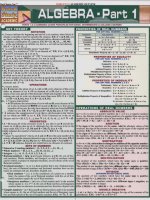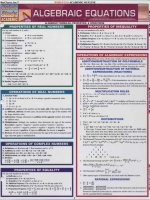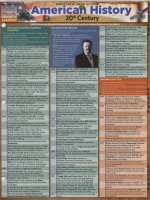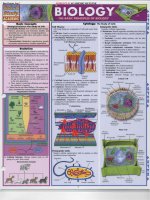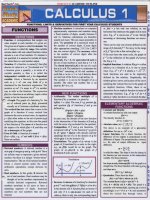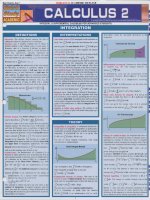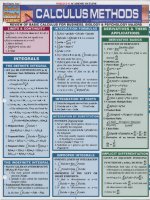Quick study home electrical 600dpi
Bạn đang xem bản rút gọn của tài liệu. Xem và tải ngay bản đầy đủ của tài liệu tại đây (11.83 MB, 6 trang )
=
=
P Power Watts
I = Intensity of Current Flow = Amps
E Electromotive Force Volts
R = Resistance (0 or Ohms)
Most of Ohm 's Law can be solved by
remembering two words: pie and ear (in
this case, spelled " eir").
=
=
EX:
To find the formula for the missing
value, place your finger over that symbol.
HOW TO CALCULATE
THE MONTHLY
ELECTRICITY COST
FOR APPLIANCES
Take the wattage (NOT
kilowatts) of your appliance
and divide it by 1,000.
Multiply the product of step
1 by the cost of electricity
per KW/HR from your power
supplier.
(TIP: This is the cost per hour to
operate the appliance.)
Multiply the cost per hour (step
2) by the estimated number
of hours the appliance will be
used per day.
Multiply cost per day (result
of step 3) by number of
days in the month (use 30
as an average) to determine
the monthly cost of using a
particular appliance.
e
e
o
o WHat is the current in a 120-volt circuit with a load of
1,800 watts?
I = PIE = 1,800 I 120 = 15 amps
What is the power consumed in watts for a 240-volt
circuit with a current draw of 25 amps?
P = I x E =25 x 240 =6 ,000 watts
What is the voltage of a circuit with a resistance of 12 0
and a current draw of 10 amps?
E = I x R = 10 x 12 = 120 volts
What is the current draw of a circuit with a voltage of
240 volts and a resistance of 25 O?
I = E I R = 240 I 25 = 9.6 amps
e
e
o
RESISTORS
The total resistance of a circuit with resistors wired in series is
equal to the sum of the resistors :
RT
=R, + R2 + R"' .......
The total resistance of a circuit with all resistors having the same
value wired in parallel is equal to the size of the resistors divided
by the number of resistors :
RT =
Size of Resistors
Number of Resistors
The total resistance of a circuit with unequal resistors wired in
parallel is equal to the reciprocal of the sum of the reciprocals of
all of the resistors in the circuit:
1
RT =
1/R, + 1/R2 + 1/R3
EX :
o What is the total resistance of a circuit with 3-12 0
resistors wired in series?
RT = 12 + 12 + 12
=36 0
e What is the total resistance of a circuit with 3-12 0
resistors wired in parallel?
RT =12 / 3=40
e What is the total resistance of a circuit with 1-60, 1-8
o and
1-12 0 resistors wired in parallel?
RT= _ _--'-_ _
1/R, + 1/R, + 1/R,
SAMPLE
CALCULATION OF
COST TO OPERATE A
4,500-WATT ELECTRIC
WATER HEATER
4 ,500 walts -;- 1,000 =4.5 KW
4.5 x .09 =$0.41 per hour
$0.41 x 4 hours per day = $1.64
$1.64 per day x 30 days =$49.20 per
month to operate
(based on 4 hours per day use and
electricity costs of 9¢ per KW/HR)
~
.14¢
.17¢
.20¢
.23¢
.54¢
66¢
.78¢
.90¢
3.6¢
4.4¢
5.2¢
6.0¢
10.8¢
13.2¢
15.6¢
180¢
13.5¢
16.5¢
19.5¢
22.5¢
16.2¢
19.8¢
23.4¢
27.0¢
18.0¢
220¢
26.0¢
30.0¢
37.8¢
46.2¢
54.6¢
630¢
40.5¢
49.5¢
58.5¢
67.5¢
720¢
88.0¢
$1.04
$1.20
0
1
m
Z
~
" , u "... 1\';:' 'uU...
Switch Row-To's
1-POLE SWITCH
3-WAY SWITCH
For illustration clarification, grounding conductors are not shown.
~---------2 conductor
wi grou nd
NM cable
Incoming Power
5
I
Single Po'! Switch
I
~
For illu stration clarification, ground ing conductors are no t show n.
~--~--------
~
_ _ _ _•
Switch 1
3WoySwltch
Wire Connector
STlJPS
o Use to switch light in one place.
e Supply power to switch using
2 conductor with ground NM
cable
(14/2 with grQlillQ for 15-amp
circuits and 12/2 with grQlillQ
for 20-amp circuits; &. use
120-volt circuit only).
Supply power to light with
same size NM cable.
Join neutrals in switch box with wire connectors (white wires) .
Join ~ in switch box with grounding connector and connect
grounding wire to switch.
Connect one "hot" (black wire) to each screw on side of switch.
• Connect lighting fixture to other end of cable.
(TIP: Color-match w ires: black to black, white to white and ground to
ground.)
e
o
o
o
STACKED SWITCH (2-1 POLE SWITCHES)
For illustration clarification, grounding conductors are not shown.
M---------
2conductof
w/ ground
NMca ~
1---- 1---~~----__
~
STlJPS
o Use to switch light in two places.
e Supply power to first switch using 2 conductor
with ground NM cable
(14/2 with ground for 15-amp circuits and 12/2
with ground for 20-amp circuits; &. use 120-volt
circuit only).
Supply power to light from second switch box
with same size NM cable.
Connect switches together using 3 conductor with
ground NM cable.
(TIP: Use same wire size as power supply cables used in steps 2 & 3.)
Join neutrals in each switch box with wire connectors (white wires).
Join ~ in each switch box with grounding connector and
connect grounding wire to switch .
• Connect the "hot" (black wire) from the 2 conductor with ground
cable to each common screw on each 3-way switch.
(TIP: Common screw is usually black.)
G Connect black and red wires from each 3 conductor with ground
cable to the gold screws on each 3-way switch.
(TIP: Either color wire may go on either gold screw.)
Ci) Connect lighting fixture to other end of 2 conductor with g[Q!.!!}Q cable.
(TIP: Co!or-match wires: black to black, white to white and 9!:Qill&!Q ground.)
e
o
o
o
3-way switches are requ ired by the National Electrical Code (NEC) at each level of the home
where there are interior stairways with 6 risers or more.
This requirement provides a way to turn on the lighting at each level to provide illumination of the
stairway.
While thi s is the only requ ired locati on of 3-way switchin g, man y areas of the home can benefit
from additional switch locations.
Study traffic patterns in the home to determine the most beneficial location for additional switches.
4-WAY SWITCH
STlJPS
o Use to switch
STBPS
o Use to switch two lights in one
place.
Supply power to switch using 2
conductor with 9IQilllQ NM cable
(14/2 with ground for 15-amp
circuits and 12/2 with ground for
20-amp circuits ; &. use 120-volt
circuit only).
Supply power to lights, with same
size NM cable to each light.
Join all neutrals in switch box
with wire connectors (white
wires).
Join all ~ in switch box with
grounding connector and connect
grounding wire to switch .
Connect "hot" (black wire) from
power supply to gold screw on side of switch with jumper between
terminals.
• Connect one "hot" (black wire) from each cable to lighting fixtures
to each gold screw on opposite side of switch.
G Connect lighting fixtures to other end of cables.
(TIP: Color-match wires: black to black, white to white and ground to
e
o
o
o
grQlillQ.)
,
........ ........ ,-.......-
" - ""
For illustration clarification. grounding conductors are not shown.
.......
NM_
.,
.,
light in three
"'
"' ""
or more
places.
Supply
power to first L-I.I - - - --~-- ..~-\-lf-~ __\+_..J
switch using
2 conductor
with ground
NM cable (14/2 with grQlillQ for 15-amp circuits and 12/2 with
ground for 20-amp circuits; &. use 120-volt circuit only).
Supply power to light from last switch box with
same size NM cable.
Connect all switches together using 3 conductor with
gmynQ NM cable.
(TIP: Use same wire size as power supply cables
used in steps 2 & 3.)
Join neutrals in each switch box with wire
connectors (white wires).
Join ~ in each switch box with grounding
connector and connect grounding wire to switch.
•
Wire first and last switch (as above for 3-way switches).
G In the middle switch boxes, connect the red and black wires from
one 3 conductor with Q..[Q.l.!.O.d cable to the terminals marked "input,"
and the red and black wires from the other 3 conductor with
ground cable to the terminals marked "output. "
Ci) Connect lighting fixture to other end of 2 conductor with g[Q!.!!}Q cable.
e
o
o
o
USING SEPARATE SWITCHES FOR SWITCHING
CEILING FAN WITH LIGHT KIT
STIIPS
o Use to switch light and fan
separately in one location.
e Supply power to 2-gang switch box
using 2 conductor with 9.IQ.\J.ill! NM
cable (14/2 with 9.IQ.\J.ill! for 15-amp
circuits and 12/2 with 9IQ.l.!.O.Q for 20
amp circuits;
.&. use 120-volt circuit only).
Supply power to fan/light from
switch box using same size 3
conductor with ground NM cable.
Join neutrals in switch box with wire
connectors (white wires) .
Join ~ in switch box with
grounding connector and connect
grounding wire to each switch.
Connect the "hot" (black wire)
from the 2 conductor with ground
cable to one gold screw on each
switch.
(TIP: Use two short black wires and wire
connector. )
8 Connect black and red wires from
3 conductor with ground cable to
one gold screw on each switch.
(TIP: Either wire may go on either
switch.)
Connect lighting fixture to other end of 3 conductor with 9IQ.l.!.O.Q cable.
(TIP: Color-match wires: black to black, white to white and ground to
ground; connect red wire to light kit - usually a blue wire, but will be
identified.)
f) .&. ALWAYS use outlet box listed for fan support.
e
o
e.
o
o
POWER FED TO THE LIGHT
STIIPS
o Alternate method to switch light
in one place.
(TIP: Used by many electricians,
especially in older homes.)
Supply power to light outlet box
using 2 conductor with 9.IQ.\J.ill!
NM cable (14/2 with 9IQ.l.!.O.Q for
15-amp circuits and 12/2 with
ground for 20-amp circuits; A
use 120-volt circuit only).
Supply power to switch from
lighting outlet box using same
size 2 conductor with ground
NM cable.
Connect white wire to one gold
screw on switch and black
wire to other gold screw on
switch.
(TIP: Re-identify white wire with
black tape or marker.)
. , Connect grounding wire to switch.
Connect black wire from power supply to white wire to switch box in
lighting outlet box with wire connector.
(TIP: Re-identify white wire with black tape or marker.)
8 Connect lighting fixture to remaining wires in lighting outlet box.
(TIP: Color-match wires: black to black, white to white and ground to
ground.)
e
e
o
o
• Smoke detectors
must be installed
in each sleeping
room of a dwelling
unit.
• Smoke detectors
must be installed
outside of each
sleeping room of
a dwelling unit.
• A single (1)
smoke detector
outside will suffice for multiple sleeping rooms (coverag e
usually extends 40 ft.; see manufacturer's instructions
included with smoke detector for more details).
Smoke detectors must be installed on each level of a dwelling
unit, including basements but not including crawl spaces or
uninhabitable attics.
Smoke detectors must be hard wired and powered by an
AFCI-protected circuit.
Smoke detectors must be interconnected so that if one
detector is activated, the alarm on all detectors will sound.
DO NOT install smoke detectors within 3 ft. of HVAC vents or
ceiling fans.
Smoke detectors are not normally recommended to be
installed in kitchens or garages (possibility of false alarms).
Smoke detectors installed on a wall must be located at least 4
in . from the ceiling and not more than 12 in. below the ceiling.
Smoke detectors located on the ceiling must be installed at
least 4 in. from the adjoining wall.
PEAKED CEILING
Smoke detectors must
be installed within 36
in. horizontally of the
peak, but not closer
than 4 in. vertically to
the peak.
TRAY CEILING
Smoke detectors
must be installed
either on the wall at
least 4 in. from the
ceiling and not more
than 12 in. below
the highest point of
the ceiling or on the
highest portion of the
ceiling at least 4 in.
from the adjoining wall.
4"
Smoke detectors
must be installed
within 36 in. of the
high side of the
ceiling, but not
36'·
closer than 4 in. from .:;;;._ _ _ _~~~~~~~~~.J
the adjoining wall.
GFCI-PROTECTED RECEPTACLE OUTLETS
DUPLEX RECEPTACLE OUTLETS
For illustration clarification, grounding conductors are not shown.
For illustration clarification, grounding conductors are not shown.
f\
Black wires to gold or brass screws
White wires to silver screws
f\
2 ( ondu(lor
wI ground
----,
NM cable
SYMBOL
=@
V
Incomlng Powo<
~~
©l
2 conductor
wI ground
NM cabte
To Remaining Oudet's
onOrcuit
8lKk wirM to gold Of brass screws
White wl res to sill/« SCrew!
• Duplex receptacles are used throughout the home to supply
power to appliances.
• Usually, power is supplied using 2 conductor with grQY!}Q NM cable.
(TIP: Use 14/2 with lJfQllllQ for 15-amp circuits and 12/2 with
ground for 20-amp circuits; & use 120-volt circuit only.)
• Multiple receptacles may be connected on the same circuit.
The 2008 National Electrical Code (NEe) requires most
receptacle outlets in homes to be tamper-resistant.
• Receptacles must be installed so that no point measured
horizontally along the floor in any wall space is more than 6 ft.
from a receptacle outlet in most habitable rooms .
Wall space is considered any space 2 ft. or more in width,
measured around corners and unbroken by fireplaces, doors or
similar openings.
Receptacle outlets in floors may be counted as those required
receptacles, if placed within 18 in. of the wall.
6 ft. rule does not apply to unfinished basements, attached or
detached garages, bathrooms, laundry rooms, hallways, kitchen
countertops or closets.
• Receptacles must be installed so that no
point measured horizontally along the
kitchen countertop is more than 2 ft. from
a receptacle outlet.
Kitchen countertop receptacles must be
supplied by at least 2 dedicated 20-amp
branch circuits.
At least 1 receptacle outlet must be installed
within 3 ft. of each bathroom sink.
S'rIIPS
o
e
e
.,
o
o
•
.,
&
f\
V
Black wires connect to gold screws.
White wires connect to silver screws.
Join grounds together and connect to
green screw.
Use 20-amp circuits for bathrooms,
kitchens, dining rooms and laundry
rooms.
Several types of connections may be
made.
Wrap wire around screw.
Push in terminals for 14 AWG wire .
Clamping mechanism on side terminals.
WARNINGI DO NOT remove too much
insulation from wires .
I"","""" """"
2 conductor
wI grou nd
SvMaOL'
=@
NMClbie
V
l~
tiJl
2 cor'KIuc:tor
"
w/groond
NMu~
~=n~~
V
Generally required in arMS ~ w.m may be pteSeflt
GFCI protection is required for 120-volt 15- and 20-amp receptacle outlets
in the following locations of dwelling units:
kitchen countertops
bathrooms
attached and detached garages
unfinished basements
crawl spaces
outdoors
• within 6 ft. of laundry, wet bar or utility sinks
GFCI receptacles are used to minimize hazards from
mixture of water and electricity.
One GFCI receptacle may protect downstream
receptacles on the same circuit.
STIIPS
o Connect incoming power supply to terminals
marked "Line."
(TIP: Black wire to gold screw, white wire to silver
screw and bare ground to green screw.)
•
Connect other duplex receptacles downstream
to terminals marked "Load."
(TIP: GFCI protection will be provided for these
receptacles as well.)
PREPARING NM CABLES FOR
TERMINATIONS
R
STIIPS
o Remove outer sheathing from cable.
(TIP: Leave at least y." of sheathing on cable
inside of box.)
•
Make a "V" with the grounds and grab with the
end of lineman's pliers.
Twist pliers clockwise four or five times while pulling outward on the
e
~.
o If a crimp sleeve is used, cut off unneeded grounds and crimp
connector to join grounds .
e If a wire connector is used, cut off unneeded grounds and join with
wire connector.
•
•
240-VOLT RECEPTACLE OUTLETS
240-volt receptacles are generally used for larger appliances such as
clothes dryers and ranges (stoves).
Usually, only one receptacle is installed on a circuit.
As a rule, power is supplied using 3 conductor with ground NM cable or
4 conductor SER cable.
.,
Terminals may be marked "X" or "Y" for "hot" wires .
(TIP: Black or red may terminate on either.)
• Terminals for neutrals (white wires) will usually be marked 'WI-I': "INhite" or "N".
STIIPS
o Use 10/3 with ground copper cables for 30-amp electric clothes dryer
outlets.
e Use 6/3 with lJfQllllQ copper cables for 50-amp electric range outlets.
Grounding conductor may be green or bare.
~
BASIC GROUNDING REQUIREMENTS
Z
Vd = Voltage Drop (in volts, do not use percentage)
III I = Current of Circuit (use actual current draw of circuit, not circuit size)
W L = One-Way Length of Circuit (distance from source of power to load served)
~ Cmil = Cross-Sectional Area of Conductor (see table below)
K = Resistance of Conductor per Circular Mil for Each Foot of Conductor
o
~
Sheet metal screws or solder not allowed for connection of
grounding devices.
• Aluminum conductors are not allowed to be terminated
outside within 18 in. of the earth.
Main bonding jumper must be installed in the service
equipment.
• Ground rods must be driven flush with grade , with at least 8
ft. in contact with the earth.
Means must be provided outside of service equipment for
bonding of other systems (telephone, cable TV, satellite
systems).
• Grounding conductors must be bare or have green
insulation (use of green tape only allowed for grounding
conductors larger than #6 AWG).
*K factor for Copper = 12 .9
*K factor for Aluminum = 21.2
SINGLE PHASE
Vd =
2x Kx LxI
Cmil
OR
Cmil = 2 x K x L x I
Vd
THREE PHASE
Vd=
1.732xKxLxl
Cmil
OR
Cmil = 1.732 x K x L x I
Vd
l
~
#14
#12
#10
#8
#6
4110
6530
10380
16510
26240
41740
52620
66360
83690
105600
133100
167800
211600
#4
#3
#2
#1
1/0
2/0
3/0
4/0
.&
21 O.19(A)(1)
FPN NO.4 suggests a
I maximum 3% voltage
drop for individual
circuit and feeder
I conductors, and a
maximum 5% overall
voltage drop for the
entire circuit.
TIP: The circular mil
I area of conductors
larger than 4/0 is
I simply the size of
I the conductor (EX:
250 kcmil = 250,000
circular mils).
EQUIPMENT GROUNDING
CONDUCTORS
I
Equipment grounding conductors are used to ground all
equipment on the load side of the service equipment.
They must be sized according to Table 250.122 of the NEC.
• Equipment grounding conductor sizes are based on the
rating of the overcurrent device protecting the circuit.
• These grounding conductors must be routed with the other
conductors of the circuit and, with few exceptions, must be
contained in the same raceway or cable assembly.
• Most cable assemblies contain bare or insulated equipment
grounding conductors that are properly sized for the
maximum circuit rating that the cable is allowed.
I
EX:
What is the voltage dropped in a 120-volt circuit that is 250 ft. long, using #12
copper conductors and supplying a load with a current draw of 14 amps?
~
Z
Voltage drop = 2 x 12.9 x 250 x 14
6,530
To find percentage of voltage drop:
13.8
=
Voltage Drop x 100
Circuit Supply Voltage
120
W%
~
o
p~
•
90 ,300 = 13.8 volts
6,530
EX:
A 20-amp circuit would require a #12 copper equipment grounding
conductor for grounding of all equipment on that circuit.
.115 x 100 = 11 .5%
This would be an excessive loss of voltage and the conductor sizes would
need to be increased to compensate. To calculate the necessary wire size
before wiring the circuit, use the following:
Sizing Grounding Conductors (based on Table 250.122)
Circuit Breaker or Fuse Size Ground Wire Size
(in Amps)
Copper
Aluminum
What minimum size copper conductors would be needed to prevent a
voltage drop in excess of 3% for a 120-volt circuit that is 250 ft. long with a
current draw of 14 amps?
Cmils=2xKxLxl = 2x12.9x250x14
Voltage Drop*
3.6
90.300
25,083.3 cmils* = #6 copper
3.6
•
•
#14
#12
#10
#8
#6
15
20
30-60
70-100
110-200
225-300
#12
#10
#8
#6
#4
#2
#4
GROUNDING ELECTRODE CONDUCTORS
Grounding electrode conductors are used to connect all portions of the
grounding electrode system together on the supply side of the service
equipment.
These conductors are required to be connected to ground rods , rebar in
footers and foundations , and metallic water piping, with at least 10ft. in
contact with the earth where they are present at each building.
They must be connected to the service equipment and their sizing is based
on Table 250.66 of the NEC, with a few exceptions.
Unlike equipment grounding conductors, grounding electrode conductors
are sized on the basis of the size of the ungrounded service entrance
conductors.
Grounding electrode conductors are used to quickly take excessive voltage
spikes caused by lightning strikes or power surges to the ground and also
serve to stabilize the normal voltage to ground.
~
Z
W EX:
~
For a service supplied with 3/0 copper service entrance conductors, a #4 copper
grounding electrode conductor is required for connection to the metallic water
piping system.
o
~
TIP: Grounding electrode conductors routed directly to ground rods are never
required to be larger than #6 copper. (Local rules may require larger.)
.& A properly installed grounding system is essential to a
safe electrical system. Some of the purposes for grounding
include: limiting voltages caused by lightning, stabilizing the
voltage under normal operating conditions, and ensuring the
facilitation of overcurrent devices under ground fault conditions.
Grounding at Services (based on Table 250 66)
Size of Service Conductors
AL
Size of Grounding Electrode Conductors
CU
AL
#2 or smaller 1/0 or smaller #8
#1-1 /0
2/0-3/0
#6
2/0-3/0
4/0-250
#4
4/0-350
#2
300-500
400-600
600-900
1/0
700-1100
1000-1 750
2/0
1750+
1100+
3/0
#6
#4
#2
CU
-
....
1/0
r
I
I
I
3/0
I
4/0
I
I
_....250
BASIC REQUIREMENTS
FOR PANELBOARDS
· 6. Connectors M..U..S.I be used to
Supply subpanels with four conductors.
(TIP: Two "hots" [black or red], one neutral
[white] and one ground [green or bare].)
8 Isolate grounds (green or bare) and
neutrals (white wires) at subpanels.
Only install one neutral (white wire) or
one "hot" (black or red wire) under
each terminal.
Bond ground bar to panel enclosure.
.6 DO NOT bond neutral bar to panel
enclosure.
. . Main breaker is not required for
subpanels if proper breaker is used for supply of the subpanel.
(EX: Supply a 1~O-amp subpanel with a breaker that is not rated over 100
amps.)
•
Multiple grounds may be installed under the same terminal if they are the
same size and material.
Aluminum and copper conductors may never be mixed under the same
terminal.
.&. ALWAYS use separate terminals for aluminum and copper.
White insulated wires, in cable assemblies, used as "hots" .M.!J..S.I be
re-identified at the termination points with black tape or black color
markings.
80 Maintain clear work space around all electrical panels .
.&. Nf.'lf.B use space in front of panels for storage.
88 6. DO NOT install panels in clothes closets or bathrooms.
88 .&. DO NOT overload service equipment! (Call a licensed electrician if
you are unsure of the load requirements.)
protect cables entering panels.
· 6. Fill in all unused holes in
panels to prevent accidental
contact with live parts.
• Use proper closure plates and
plugs.
.&. WARNINGI DO NOT use duct
tape.
• Only use correct breaker types for
panels.
(EX: GE breakers in GE panels only;
Siemens breakers in Siemens
panels only; etc.)
Label panels correctly after
installing new circuits or doing
renovations.
The 2008 National Electrical Code
(NEe) requires most circuits in
homes to be protected by an Arc
Fault-Circuit-Interrupter circuit
breaker.
wi ground
Copper NM
e
o
e
e
o
wi ground
Copper NM
#1212
Refrigeratorl
Freezer
wi ground
X
CopperNM
X
#1 212
wi ground
Copper NM
#1412
#1212
wi ground
CopperNM
wi ground
#1412
#1212
wi ground
Copper NM
wi ground
Copper NM
CopperNM
X
X
X
X
X
X
X
X
Oven!
#1013
1/813
Cooktop
wi ground
w/ground
CopperNM
X
X
CopperNM
l/616l6I8
ALSER
Free
Standing
Range
X
X
X
Heater
Clothes
Dryer
Hydromassage Tub
l
U.S. $5.95
X
X
X
X
X
#1212
wi ground
CopperNM
#4141416
ALSER
wi ground
CopperNM
#8161618
#4141416
X
X
X
wi ground
CopperNM
#1013
wi ground
Copper NM
X
[NOTE: This table is used for service
entrance conductors and feeders if the feeder
supplies the entire load of dwelling unit.]
CopperNM
wi ground
CopperNM
#10/2
SERVICE & FEEDER
CONDUCTOR SIZES
FOR DWELLING UNITS
1/813
wi ground
#813
ALSER
X
X
X
CIRCUIT BREAKER
& CABLE SIZES FOR
SMALL CIRCUITS
15
#14
20
#12
25
#10
30
#10
35
#2
#4
#8
#8
#6
#1
#3
40
#8
#8
#6
125
1/0
#2
45
#6
#6
#4
150
2/0
#1
50
#6
#6
#4
110
175
3/0
1/0
200
4/0
2/0
225
250
3/0
250
300
4/0
300
350
250
350
500
350
400
600
400
Table is ba sed on excerpts from 240.6, Table
310.16 .240.4(0 ). and 334.80 (assumlng . II
terminal provisions are listed fer 75 degrees C.)
AUTHOR: Ch ris Prince; James Da niel Sa ndefur, SME
ISBN-13 : 978-142320889-1
ISBN-10 : 142320889-7
DISCLAIMER: Thi s guide is intended for informational purposes only. Due
to its conde nsed format, it cannot possibly cover every aspect of the subject
and should not be used as a substitute for advice from a licen sed electrician
BarCha rts , Inc .. its writers, editors and designers are not responsible or liable for
the use or misuse of the information contai ned in this guide.
o
~
X
X
X
#813
ALSER
Water
X
CONDUCTOR & CABLE SIZES FOR TYPICAL
HOUSEHOLD CIRCUITS
A ll righls reserved . No part of this publicfltion may be rep rod uced or transmItted in any form. or by
any means, electronic or mcc h,m ical. including photocopy. record mg , or any information storage
and retrieval system. without writtfln permissi on from the publisher
it2009 Ba rC harts, Inc. 1209
9
~m~ ~lllWlj I rl l 1rl ll~ 1
Customer Hotline
# 1.800.230.9522
free downloads &
hun d\l3.dS,pf titlils at
QUICKS1:Uay.com
,tlLUJ
3

